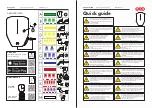
ing on a significantly underinflated tire causes the tire
to overheat and can lead to tire failure. Underinflation
also reduces fuel efficiency and tire tread life, and may
affect the vehicle’s handling and stopping ability.
Please note that the TPMS is not a substitute for proper
tire maintenance, and it is the driver’s responsibility to
maintain correct tire pressure, even if underinflation
has not reached the level to trigger illumination of the
TPMS low tire pressure telltale.
Your vehicle has also been equipped with a TPMS mal-
function indicator to indicate when the system is not
operating properly. The TPMS malfunction indicator is
combined with the low tire pressure telltale. When the
system detects a malfunction, the telltale will flash for
approximately one minute and then remain continu-
ously illuminated. This sequence will continue upon
subsequent vehicle start-ups as long as the malfunc-
tion exists. When the malfunction indicator is illumi-
nated, the system may not be able to detect or signal
low tire pressure as intended. TPMS malfunctions may
occur for a variety of reasons, including the installation
of replacement or alternate tires or wheels on the
vehicle that prevent the TPMS from functioning prop-
erly. Always check the TPMS malfunction telltale after
replacing one or more tires or wheels on your vehicle to
ensure that the replacement or alternate tires and
wheels allow the TPMS to continue to function properly.
CAUTION!
The TPMS has been optimized for the original equip-
ment tires and wheels. TPMS pressures and warning
have been established for the tire size equipped on
your vehicle. Undesirable system operation or sensor
damage may result when using replacement equip-
ment that is not of the same size, type, and/or style.
(Continued)
CAUTION!
Aftermarket wheels can cause sensor damage. Using
aftermarket tire sealants may cause the Tire Pressure
Monitoring System (TPMS) sensor to become inoper-
able. After using an aftermarket tire sealant it is rec-
ommended that you take your vehicle to an autho-
rized dealer to have your sensor function checked.
Anti-Lock Brake System (ABS) Warning
Light
This warning light monitors the Anti-Lock
Brake System (ABS). The light will turn on
when the ignition is placed in the ON/RUN or
ACC/ON/RUN position and may stay on for
as long as four seconds.
If the ABS light remains on or turns on while driving,
then the Anti-Lock portion of the brake system is not
functioning and service is required as soon as possible.
However, the conventional brake system will continue to
operate normally, assuming the Brake Warning Light is
not also on.
If the ABS light does not turn on when the ignition is
placed in the ON/RUN or ACC/ON/RUN position, have
the brake system inspected by an authorized dealer.
Rear Axle Locker Fault Indicator Light —
If Equipped
This warning light will illuminate to indicate
when a rear axle locker fault has been
detected.
Refer to “Axle Locker System — Power Wagon
Models Only (If Equipped)” in “Starting And Operating”
for further information.
Service Forward Collision Warning
(FCW) Light — If Equipped
This warning light will illuminate to indicate a
fault in the Forward Collision Warning Sys-
tem. Contact an authorized dealer for
service.
Refer to "Forward Collision Warning (FCW)" in "Safety"
for further information.
Service 4WD Warning Light —
If Equipped
This warning light will illuminate to signal a
fault with the 4WD system. If the light stays
on or comes on during driving, it means that
the 4WD system is not functioning properly
and that service is required. We recommend you drive
to the nearest service center and have the vehicle ser-
viced immediately.
Speed Control Fault Warning Light
This warning light will illuminate to indicate
the Speed Control System is not functioning
properly and service is required. Contact an
authorized dealer.
Sway Bar Fault Warning Light
This light will illuminate when there is a fault
in the sway bar disconnect system.
Refer to “Stabilizer/Sway Bar System —
Power Wagon Only” in “Starting And Operat-
ing” for further information.
106
GETTING TO KNOW YOUR INSTRUMENT PANEL
















































